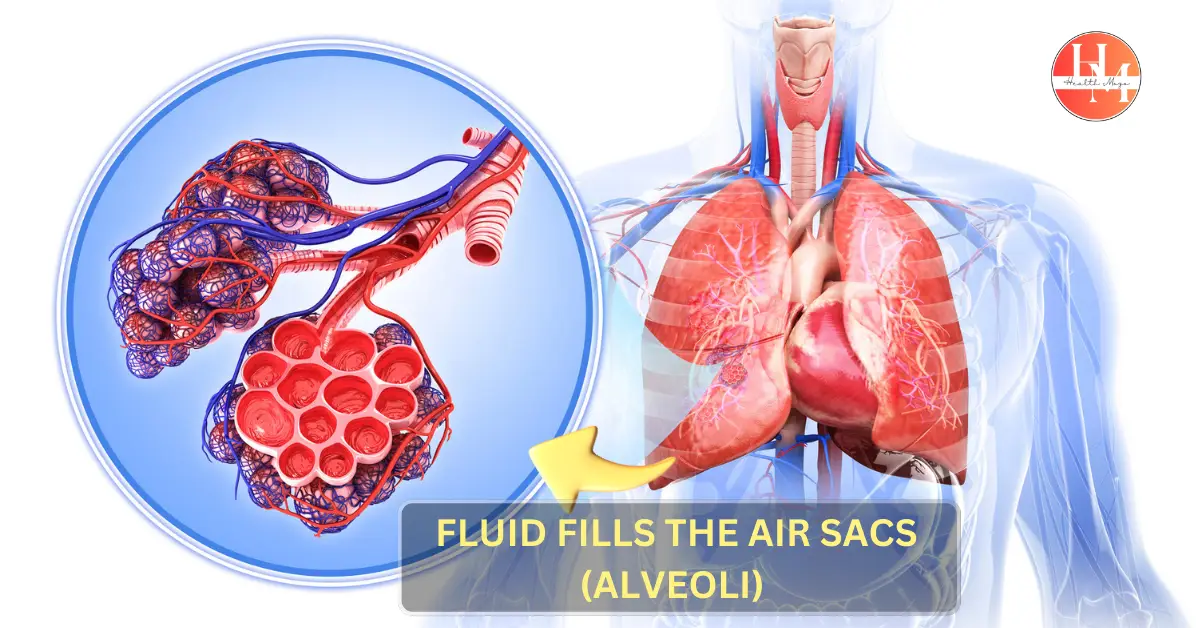Pulmonary edema is a serious medical condition where fluid accumulates in the lungs, making it difficult to breathe. This condition requires prompt attention and medical intervention, as it can lead to life-threatening complications if not treated in time. In this article, we will explore the causes, symptoms, and early warning signs of P. edema to help you better understand the condition.
Contents
What is Pulmonary Edema?
Pulmonary edema occurs when fluid fills the air sacs (alveoli) in the lungs, leading to impaired gas exchange and breathing difficulties. This condition can be acute (sudden onset) or chronic (developing over time), depending on the underlying cause.
Causes of Pulmonary Edema
- High blood pressure in the lungs: When the pressure in the blood vessels of the lungs is too high, it can push fluid out into the surrounding tissues.
- Fluid buildup in the lung tissues: If the tissues in the lungs can’t drain the fluid away fast enough, it can build up.
- Damage to the lung’s lining: If the lining of the lungs is damaged, it can’t keep fluid from leaking out.
- Low protein levels in the blood: Proteins in the blood help to keep fluid from leaking out of blood vessels. If there are fewer proteins, more fluid can leak out.
- Problems with the lymphatic system: The lymphatic system helps to drain fluid from the body. If it’s not working properly, fluid can build up.
- Negative pressure in the lungs: Sometimes, the pressure in the lungs can be too low, which can pull fluid into the lungs
There are two main types of P. edema: cardiogenic and non-cardiogenic, each with different causes.
1-Cardiogenic Pulmonary Edema
This type is caused by heart problems. When the heart is unable to pump blood efficiently, it causes an increase in pressure in the blood vessels of the lungs, leading to fluid leakage into the lungs.
- Heart failure: The most common cause of cardiogenic P. edema.
- Heart attack: Can weaken the heart, causing fluid buildup.
- High blood pressure: Increases the workload on the heart, leading to fluid accumulation in the lungs.
- Valve disorders: Malfunctioning heart valves can increase pressure in the lungs.
2-Non-Cardiogenic Pulmonary Edema
This form is not related to heart problems but results from other conditions that cause fluid to leak into the lungs.
- Inhalation of toxins: Such as smoke or harmful chemicals.
- Acute Respiratory Distress Syndrome (ARDS): A severe lung condition that causes inflammation and fluid accumulation.
- Negative Pressure P. Edema: This occurs when an airway obstruction causes a sudden change in pressure in the lungs, leading to fluid leakage.
- Altitude sickness: Exposure to high altitudes can cause fluid buildup in the lungs.
Symptoms of Pulmonary Edema
Recognizing the symptoms of pulmonary edema early is essential for prompt treatment. Symptoms can vary depending on the severity and type of P. edema but typically include:
Common Symptoms
- Shortness of breath: This is one of the hallmark symptoms, especially during physical activity or while lying down.
- Coughing: A persistent cough, often with frothy, pink-tinged sputum.
- Rapid, shallow breathing: Breathing becomes quick and shallow as the lungs struggle to function properly.
- Wheezing: A high-pitched sound when breathing, caused by narrowed airways.
- Fatigue: Difficulty breathing can lead to exhaustion and weakness.
Severe Symptoms
- Chest pain: Especially if pulmonary edema is caused by a heart attack.
- Dizziness or lightheadedness: Caused by a lack of oxygen in the body.
- Swelling in the legs or ankles: A sign of fluid buildup in the body.
Early Warning Signs of Pulmonary Edema
Being aware of the early signs can help prevent serious complications. These warning signs often include:
- Increased shortness of breath during activity or while lying flat.
- Waking up breathless at night or feeling like you’re drowning.
- Rapid weight gain due to fluid retention.
- Persistent coughing or wheezing, especially when lying down.
Diagnosis and Treatment
Diagnosis of Pulmonary Edema
Pulmonary edema, a condition characterized by excess fluid in the lungs, can be a medical emergency. Accurate and timely diagnosis is important for effective treatment. Here are the common methods used to diagnose:

1. Medical History and Physical Examination
- Symptoms: A thorough review of the patient’s symptoms, such as shortness of breath, cough, rapid breathing, and pink frothy sputum, can provide valuable clues.
- Physical Examination: A doctor will listen to the patient’s lungs for crackles or rales, which are indicative of fluid buildup. They may also check for other signs of heart failure or other underlying conditions.
2. Chest X-ray
- Fluid Accumulation: A chest X-ray can reveal fluid in the lungs, appearing as a hazy or white appearance.
- Heart Enlargement: In cases of heart failure-related pulmonary edema, the X-ray may show an enlarged heart.
3. Echocardiogram
- Heart Function: This test uses sound waves to create images of the heart, helping to assess its function and identify any underlying heart conditions that may be contributing to pulmonary edema.
4. Electrocardiogram (ECG)
- Heart Rhythm: An ECG can detect abnormal heart rhythms or other heart problems that may be associated with pulmonary edema.
5. Blood Tests
- Oxygen Levels: Blood tests can measure oxygen levels in the blood, which may be low in pulmonary-edema.
- Other Markers: Certain blood tests can help identify underlying conditions, such as heart failure or kidney disease.
6. Pulmonary Function Tests
- Lung Capacity: These tests measure how well the lungs function, which can be helpful in diagnosing pulmonary-edema and other lung conditions.
7. BNP (B-type Natriuretic Peptide) Test
- Heart Failure Marker: BNP is a protein released by the heart in response to stress. Elevated BNP levels can be indicative of heart failure, a common cause of pulmonary edema.
In some cases, additional tests, such as a CT scan or MRI, may be needed to rule out other conditions or provide more detailed information about the lungs and heart.
Treatment Options
Treatment of pulmonary edema depends on the patient’s condition and the underlying cause. However, the primary goal is to reduce fluid buildup in the lungs and improve breathing. Here are some common treatment approaches:
1. Oxygen Therapy
Supplemental Oxygen: Providing supplemental oxygen helps to increase oxygen levels in the blood and improve breathing.
2. Diuretics
Fluid Removal: Diuretics (water pills) help the body eliminate excess fluid, reducing the pressure on the lungs.
3. Nitroglycerin
Vasodilation: Nitroglycerin helps to dilate blood vessels, reducing the workload on the heart and improving blood flow.
4. Morphine
Pain Relief and Anxiety: Morphine can help relieve pain and anxiety, which can worsen shortness of breath.
5. Positive Pressure Ventilation
Mechanical Support: In severe cases, a ventilator may be needed to help the lungs breathe.
6. Treatment of Underlying Causes
- Heart Failure: If pulmonary edema is caused by heart failure, treatment may involve medications to strengthen the heart or surgery to improve heart function.
- Other Conditions: Depending on the underlying cause, other treatments may be necessary, such as antibiotics for infections or blood thinners for blood clots.
7. Lifestyle Changes
- Diet and Exercise: A healthy diet and regular exercise can help manage underlying conditions like heart failure and improve overall health.
- Fluid Restriction: In some cases, doctors may recommend limiting fluid intake to help reduce fluid buildup.
The specific treatment plan will vary depending on the severity of pulmonary edema and the underlying cause. It’s important to follow your doctor’s instructions and seek immediate medical attention if your symptoms worsen.
FAQ’s,
1. What is pulmonary edema and how does it affect the lungs?
Pulmonary edema occurs when fluid accumulates in the alveoli (air sacs) of the lungs, making it difficult for oxygen to enter the bloodstream. This leads to breathing difficulties and other serious health issues if left untreated.
2. What are the common causes of pulmonary edema?
The primary causes of P. edema include heart conditions (such as congestive heart failure), high-altitude exposure, pneumonia, kidney failure, and certain medications or toxins.
3. What are the symptoms of pulmonary edema?
Symptoms include shortness of breath, rapid breathing, a feeling of suffocation, coughing up pink, frothy sputum, excessive sweating, and a bluish tinge to the skin due to lack of oxygen.
4. How is pulmonary edema diagnosed?
P. edema is diagnosed through a combination of a physical examination, medical history, chest X-rays, blood tests, and possibly an echocardiogram or other imaging tests to assess the lungs and heart function.
5. Can pulmonary edema be prevented or treated?
Treatment focuses on addressing the underlying cause, such as improving heart function or managing infections. Prevention involves maintaining good heart health, avoiding high altitudes if susceptible, and managing risk factors like hypertension and kidney disease.

